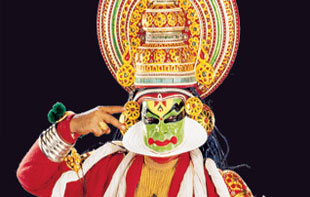Kerala.com Travel Division
WorldViewer Dot Com (India) Pvt. Ltd.
II Floor, G 66, Elders Forum Road
Panampilly Nagar, Cochin, Kerala, India
Pin - 682 036
Mobile: + 91 98460 43403
Mobile: + 91 93886 40364

 The art form of Kathakali is a highly stylised classical dance-drama of Kerala noted for its attractive make-up of characters, their elaborate costumes, detailed gestures and well-defined body movements presented in tune with the anchor playback music and complementary percussion. It originated in the countrys southern state of Kerala during the 16th century AD, approximately between 1555 and 1605, and has been updated over the years with improved looks, refined gestures and added themes besides more ornate singing and precise drumming.
The art form of Kathakali is a highly stylised classical dance-drama of Kerala noted for its attractive make-up of characters, their elaborate costumes, detailed gestures and well-defined body movements presented in tune with the anchor playback music and complementary percussion. It originated in the countrys southern state of Kerala during the 16th century AD, approximately between 1555 and 1605, and has been updated over the years with improved looks, refined gestures and added themes besides more ornate singing and precise drumming.
Kathakali incorporates several other elements from traditional and ritualistic art forms like Mudiyettu, Thiyyattu, Theyyam and Padayani besides a minor share of folk arts like Porattunatakam. All along, the martial art of Kalarippayattu has influenced the body language of Kathakali. The use of Malayalam, the local language (albeit as a mix of Sanskrit and Malayalam, called Manipravalam), has also helped the literature of Kathakali sound more transparent for the average audience. The characters with painted faces and elaborate costumes present their plays based on Hindu epics. Kathakali has traditionally been performed in temples and palaces, but over the past century it also finds venues in post-harvest paddy fields and, since the last few decades, in proscenium stages of public halls/auditoria and even in pagentry shows of tourism of late.These stage shows which have become part and parcel of tourism in Kerala, have been very popular among the travelers especially foreigners visiting Ernakulam city.
Detailed gestures
The name Kathakali derives from the Malayalam words "katha" (meaning story) and "kali" (meaning play).
Kathakali is considered to be a combination of five elements of fine art:
• Expressions (Natyam, the component with emphasis on facial expressions)
• Dance (Nritham, the component of dance with emphasis on rhythm and movement of hands, legs and body)
• Enactment (Nrithyam, the element of drama with emphasis on "mudras", which are hand gestures)
• Song/vocal accompaniment (Geetha)
•Instrument accompaniment (Vadyam)
Even though the lyrics/literature would qualify as another independent element called Sahithyam, it is considered as a component of Geetha or music, as it plays only a supplementary role to Nritham, Nrithyam and Natyam.
For more details on the queen of the Arabian Sea, log on to ernakulam.com
For Accommodation - Hotels / Resorts / Homestays in Ernakulam
WorldViewer Dot Com (India) Pvt. Ltd.
II Floor, G 66, Elders Forum Road
Panampilly Nagar, Cochin, Kerala, India
Pin - 682 036
Mobile: + 91 98460 43403
Mobile: + 91 93886 40364

Kerala Districts : Alappuzha | Ernakulam | Idukki | Kannur | Kollam | Kottayam | Kozhikode | Kasargod | Malappuram | Pathanamthitta |Palakkad | Thiruvananthapuram | Trichur | Wayanad
Other Destinations :Nelliyampathy | Kodanad | Fortkochi | Marari | Kulamavu| Cherai | Kanyakumari | Kumbalangi| Kuttikanam | Ramakkalmedu|Vaikom |